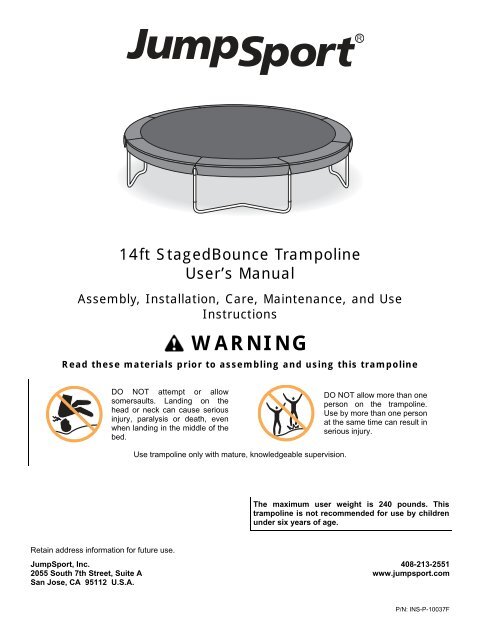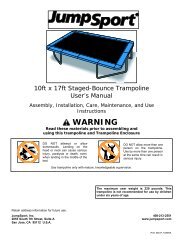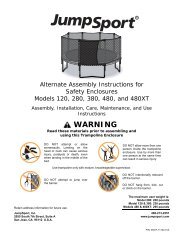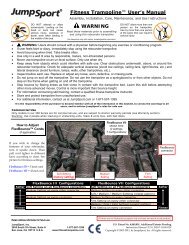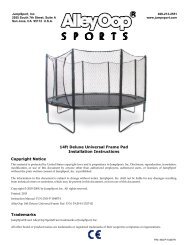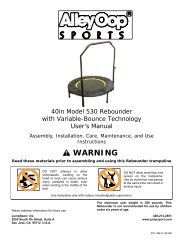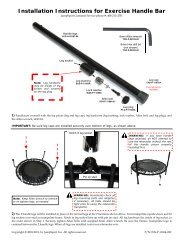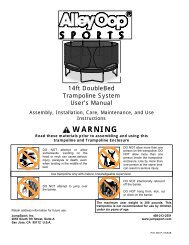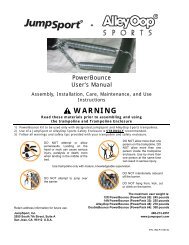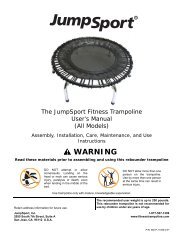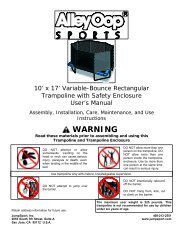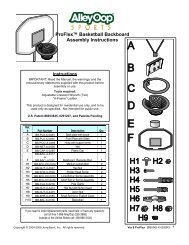14' StagedBounce Trampoline User's Manual - JumpSport
14' StagedBounce Trampoline User's Manual - JumpSport
14' StagedBounce Trampoline User's Manual - JumpSport
Create successful ePaper yourself
Turn your PDF publications into a flip-book with our unique Google optimized e-Paper software.
14ft <strong>StagedBounce</strong> <strong>Trampoline</strong>User’s <strong>Manual</strong>Assembly, Installation, Care, Maintenance, and UseInstructionsWARNINGRead these materials prior to assembling and using this trampolineDO NOT attempt or allowsomersaults. Landing on thehead or neck can cause seriousinjury, paralysis or death, evenwhen landing in the middle of thebed.DO NOT allow more than oneperson on the trampoline.Use by more than one personat the same time can result inserious injury.Use trampoline only with mature, knowledgeable supervision.The maximum user weight is 240 pounds. Thistrampoline is not recommended for use by childrenunder six years of age.Retain address information for future use.<strong>JumpSport</strong>, Inc.2055 South 7th Street, Suite ASan Jose, CA 95112 U.S.A.408-213-2551www.jumpsport.com1P/N: INS-P-10037F
Copyright NoticeThis material is protected by United States copyright laws and is proprietary to <strong>JumpSport</strong>, Inc. Disclosure, reproduction, translation,modification, or use of this document by anyone other than authorized employees, authorized users, or licensees of <strong>JumpSport</strong>without the prior written consent of <strong>JumpSport</strong>, Inc. is prohibited.The information in this document is subject to change without notice. <strong>JumpSport</strong>, Inc. shall not be liable for any damages resultingfrom technical errors or omissions, which may be present in this document, or from use of this document.Copyright © 2002-2008, by <strong>JumpSport</strong>, Inc. All rights reserved.Printed: 2008Instruction <strong>Manual</strong> P/N: INS-P-10037F<strong>JumpSport</strong> 14ft <strong>StagedBounce</strong> <strong>Trampoline</strong> P/N: TRJ-S-10961A / TRJ-S-11027A<strong>JumpSport</strong> 14ft PowerBounce <strong>Trampoline</strong> P/N: TRJ-U-10982A / TRJ-S-11039ATrademarks<strong>JumpSport</strong>®, <strong>StagedBounce</strong>, PowerBounce, Sure-Lok, and SureStep <strong>Trampoline</strong> Ladder are trademarks of <strong>JumpSport</strong>, Inc.All other brand or product names are trademarks or registered trademarks of their respective companies or organizations.PatentsThis product includes technology associated with one or more of the following U.S. Patents:No. 6,053,845No. 6,261,207No. 6,840,891No. 6,846,271No. 7,060,001Additional Patents Pending.How to Contact Customer SupportShould you require customer service or technical support for your <strong>JumpSport</strong> 14ft <strong>StagedBounce</strong> <strong>Trampoline</strong>, please contact Jump-Sport’s Customer Service department at:408-213-25518:00am—5:00pm Monday through Friday, Pacific Time2
ContentsChapter 1 Introduction 5<strong>JumpSport</strong> Safety Enclosure 6Chapter 2 Assembly and Installation Instructions 7Preparation 7<strong>Trampoline</strong> Placement 7Tools 8Parts List 8Assembly 10Final Steps 16Disassembly 16Chapter 3 Care and Maintenance Instructions 17Inspection 17<strong>Trampoline</strong> Mat 17Cold Weather Protection 18Replacement Parts 18Disassembly 18Care and Maintenance Safety Checklist 19Windy Conditions 20Moving the <strong>Trampoline</strong> 20Care 20Chapter 4 Warning Information 21Points of Safety 21Landing on Springs or Frame 21Bouncing off the <strong>Trampoline</strong> 21Landing Incorrectly on the Mat 22Chapter 5 Use Instructions 23Safety Rules 23Basic Skills 24Bouncing 24Stop Bounce 24Arm Action 24Bounce Variations 25Basic Landing Positions 25Seat Drop 25Hands and Knees Drop 26Front Drop 26Series of Drops 27Twisting Moves 27Swivel Hips 27Turntable 28Twist Variations 28Warranty InformationLast Page3
(This page left intentionally blank.)4
Introduction 1Congratulations on purchasing a <strong>JumpSport</strong> trampoline! We sincerely believe that you have purchased the finest roundtrampoline on the market. It has been engineered with safety, durability, and performance in mind. As a result, thisproduct features our <strong>StagedBounce</strong> mat system and our Sure-Lok rail system.Safe use of a trampoline also requires adequate knowledge of technique, as well as what not to do. Please read thismanual thoroughly for key points of safety.<strong>Trampoline</strong>s, being rebounding devices, propel the performer to unaccustomed heights and into a variety of bodymovements. Therefore, it is emphasized that all purchasers, and all persons using the trampoline, become familiar withthe rules for safe use. Misuse and abuse of this trampoline is dangerous, and can cause serious injuries. The purchaser/user of this piece of equipment is assuming a degree of risk for which <strong>JumpSport</strong> cannot be responsible.Read this information thoroughly before allowing the trampoline to be used. Keep this manual available for yourreview, and for review by all potential users. If there are questions please call <strong>JumpSport</strong> for further explanation.Caution<strong>JumpSport</strong> trampolines are designed exclusively for the home backyard market. Many users of our trampolines arechildren, and therefore need close supervision and rules to follow while playing on the trampoline. These rules must beenforced by whomever is responsible for the care of the children. It is strongly recommended that the buyer of thisproduct go over the rules and recommendations in the packet of information supplied, including those in this manual. Itis also strongly recommended that these rules and recommendations be supplemented with those of your own, forexample: the time that jumping is allowed, when neighbors can visit, and so on. These rules and recommendationsshould be reviewed with anyone who is going to jump on the trampoline. If it is possible, review these rules with theparents or guardians of any visitors who may be jumping on the trampoline. See Safety Rules (under the Use Instructionssection) for more information.Recommended weight limitation is no more than 240 pounds. Persons at, or near this weight should test the resiliency ofthe springs prior to extensive bouncing. Do this by jumping lightly on the mat. If the resiliency appears to be weak (matdoes not lift the individual when light jumps are made), discontinue bouncing immediately, take off the springs andinspect them. If the springs appear to be stretched out of shape, the mat should not be put back on until the springs havebeen replaced. Be sure to check the mat for any areas that need re-stitching, or V-rings that may need replacing.We also urge you to not keep any ladder, step stool, or other climbing device next to the trampoline when use of thetrampoline is not supervised by an adult. This precaution helps to prevent access to the trampoline by individuals thatare too small, or do not have the physical strength necessary to jump on a trampoline without having the propersupervision.5
IntroductionDue to the risks associated with users falling off oftrampolines, we strongly urge you to use a <strong>JumpSport</strong>Safety Enclosure in conjunction with your trampoline.Please call <strong>JumpSport</strong> if you have any questions aboutsuch a device.<strong>JumpSport</strong> Safety EnclosureStudies show that many of the injuries associated with trampoline use in a residential setting are a result of the userfalling off of the trampoline and hitting the ground or some other object. For this reason, it is strongly recommended thata <strong>JumpSport</strong> Safety Enclosure be used in conjunction with your trampoline. The <strong>JumpSport</strong> Safety Enclosure should beused as a supplement to mature, knowledgeable supervision – not a substitute. The <strong>JumpSport</strong> enclosure can also belocked to prevent unauthorized use. Please contact <strong>JumpSport</strong> to learn more about our patented Safety Enclosures.Protect your family with a <strong>JumpSport</strong> Safety Enclosure.Diagram 1 <strong>JumpSport</strong> Safety Enclosure6
Assembly and InstallationInstructions 2PreparationBefore you begin assembling your <strong>JumpSport</strong> 14ft <strong>StagedBounce</strong> <strong>Trampoline</strong>, make sure your trampoline is in a properlocation.<strong>Trampoline</strong> PlacementCaution: When deciding on where to place your trampoline, consider the following:WARNINGOverhead ClearanceLateral ClearanceLevel SurfaceLightingSecurityGround ClearanceAdequate overhead clearance is essential. A minimum of 24 feet from ground levelis recommended. Provide clearance for wires, tree limbs, and other possible hazards.Lateral clearance is essential. Place the trampoline away from walls, structures, fences,and other play areas. Maintain a clear space on all sides of the trampoline.Place the trampoline on a level surface before use.Use the trampoline in a well-lit area. Artificial illumination may be required for indooror shady areas.Secure the trampoline against unauthorized and unsupervised use.Remove any obstructions from beneath the trampoline.Note: The owner and supervisors of the trampoline are responsible to make all users aware of practices specified inthe Use Instructions.IMPORTANT: The best surface on which to place your trampoline is dirt or grass. However, if you plan to install thetrampoline on a very hard surface such as concrete or asphalt, a dense foam — similar to what can be found inpublic playgrounds — should be installed under each leg. Contact <strong>JumpSport</strong> Customer Service if you have anyquestions.It is the responsibility of the purchaser to become familiar with all of the information in this booklet, toconvey the warnings to all users, and to enforce <strong>JumpSport</strong>’s rules for safe use.This unit is not intended for commercial or public use and is therefore strictly prohibited.The maximum user weight is 240 pounds.This trampoline is not recommended for use by children under six years of age.7
Assembly and Installation InstructionsToolsNo tools are required for installation of the trampoline. However, safety glasses and gloves are recommended for safety.Parts ListYour 14ft <strong>StagedBounce</strong> <strong>Trampoline</strong> is shipped with the parts shown below. The trampoline parts ship in 2 separateboxes which may arrive on different days. If any parts are missing, immediately call <strong>JumpSport</strong> Customer Service at408-213-2551.Reference # Part # Description Quantity1 LEG-P-10034A Horizontal leg piece 42 LEG-P-10033A Vertical leg piece 83 RAI-P-10032B Rail piece with 2 leg sockets, 12 spring notches 44 RAI-P-10031A Rail piece with no leg sockets, 12 spring notches 45 MAT-P-10035A Mat, 96 V-rings 16 SPR-P-10059A Spring, 8.5 inches 967a PAD-P-10945A Frame pad section 87b PAD-P-10954A Pad connector, with Velcro (connects frame pad sections) 167c BUN-P-10160A Pad bungee, with plastic "T" (fits frame pad) 87d BUN-P-10755A Button T-anchor (fits pad connectors) 88 CAB-P-10116A Cable tie 19 PLC-P-10141B Warning placard 18
Assembly and Installation InstructionsThe following pages contain diagrams, pictures, and written instructions for assembling your 14ft <strong>StagedBounce</strong><strong>Trampoline</strong>. The “Ref. #” mentioned in many Steps is referring to the “Reference #” column of the parts list on theprevious pages.Familiarize yourself with the Assembly and Installation Instructions before beginning installation.For installation questions, please contact <strong>JumpSport</strong>’s Customer Service department at:408-213-25518:00am—5:00pm Monday through Friday, Pacific TimeCAUTIONPinch point.Pay careful attention to handposition when connecting tubesand handling springs.9
Assembly and Installation InstructionsAssemblyNote: We recommend at least 2 people participate in assembling the trampoline. Use page 8 to help with partnames and numbers.Rail with 2leg socketsRef. #3Rail with noleg socketsRef. #4Vertical legpieceRef. #2Horizontalleg pieceRef. #1(Top view)2) Using 1 horizontal leg piece and 2 vertical leg pieces, build aleg assembly as shown above.1) Lay all rail and leg pieces in a circle as shown. See page 8 fordetailed part descriptions.>> Repeat with all remaining leg pieces. When finished, you willhave 4 complete leg assemblies.Leg assembly3) Stand 1 leg assembly upright and connect a rail with 2 socketsas shown.4) Connect another leg assembly to the same rail with 2 sockets.10
Assembly and Installation Instructions5) Connect rail with no sockets, then rail with 2 sockets. 6) Connect next leg assembly to rail with 2 sockets.>> Repeat Steps 5 and 6 all the way around until all rail piecesand leg assemblies are attached.7) Completed frame.11
Assembly and Installation InstructionsWarning label onmat facing upMatRef. #5SpringRef. #6Warning label onmat facing up(Top view)8) Connect jumping mat to trampoline frame using 4 springs.Connect each spring to a V-ring and spring notch, approximately1/4 circle apart from each other. Warning labels must face up.Note: For this Step, the springs do not have to be perfectlyspaced. They are to help keep tension on the mat while youattach the remaining springs.TIP: For easy spring installation, connect spring to V-ring of matand pull toward you, to connect to frame. Use a second spring asa tool to hook onto the one you are installing.IMPORTANT: If you have a PowerBounce <strong>Trampoline</strong>, open theseparate PowerBounce box and use those instructions to installthe PowerBounce springs while you install the standard springsin the following steps.SpringRef. #6V-ringsSpringRef. #6Spring notches(Top view)(Top view)9) Start at a spring that is already connected. While standingoutside the frame, count 4 V-rings and spring notches clockwise,and connect another spring. The easiest way to connect a spring isto hook spring onto V-ring, then pull it toward you and hook itinto spring notch on top of frame rail.10) Continue counting 4 V-rings and notches and connecting aspring until you have gone all the way around the trampoline.When you get to a spring that you connected in Step 8, repositionit if necessary, so that the springs are all spaced exactly 4 V-ringsand spring notches apart.12
Assembly and Installation InstructionsPerson 2(Top view)Person 1(Top view)11) Now connect a spring to every middle V-ring and springnotch, working clockwise around the trampoline. Have someonework across from you, also going clockwise.Note: It is important to have someone working across from you.Otherwise the springs could become over-extended, causingthem to become difficult to attach.12) Connect all the remaining springs to the trampoline, againworking clockwise, with someone working across from you.Frame pad sectionRef. #7aSmall flaps inpad skirtWARNING: <strong>Trampoline</strong> use is not recommended without the framepad installed (see Picture on page 16). The frame pad is designedto reduce the possibility of injury by protecting the user from cominginto contact with the frame and springs of the trampoline. It is veryimportant that you properly and securely attach the frame pad to the frame,and that it is in the correct position prior to using the trampoline.13) Lay the 8 frame pad sections on the trampoline to create a full circle around the trampoline frame. Metal grommets on each padsection should face the ground. Align pad so that small flaps on outside edge of pad skirt line up over each leg of trampoline.13
Assembly and Installation InstructionsPad connectorRef. #7bPad connectorGrommet on insideedge of padPad connector14) Two pad connectors are used to connect adjacent pad sections together; one pad connector connects to the top of each pad sectionand the second pad connector connects to the bottom of each pad section. Grommet on each pad connector must be on inside edge ofpad (closest to jumping mat).Pad bungeeRef. #7cFrame pad(Sideview)Rail with 2 sockets“T” end ofpad bungeeLooped end ofpad bungee15) Install pad bungees through the 2 metal grommets near outsideedge of pad, as shown. Grommets should be on bottom sideof pad near each leg.16) Wrap looped end of pad bungee around leg of trampoline, asshown. Then wrap looped end around the “T” on the oppositeend of the bungee.Note: Bungee should NOT wrap around rail of trampoline. Itshould only wrap around the leg.14
Assembly and Installation InstructionsGrommet onpad connector(View showingbottom side of pad)ButtonInside edge offrame pad(closest to mat)KnotNote: Length of button T-anchorbungee may vary.ButtonButton T-anchorRef. #7dButton(View showingtop side of pad)17) If you are going to install a safety enclosure, skip to Step 19.If you are not going to install a safety enclosure, install a button T-anchor through the grommets in each pair of pad connectors asshown (starting from bottom side of frame pad). Buttons must be flush with pad connectors, and knot must be tied securely to holdtop button in place. There should be no slack between the bottom knot and the top knot you just tied.(View of bottomof frame pad)Cable tieRef. #8! !Punch hole hereDo not a low more thanone person on theWARNINGtrampoline. Use by morethan one person a the1) Do not a tempt or a low somersaults. Serious injuries, paralysis or death mayNot recommended for use without a <strong>JumpSport</strong> safety enclosure.same time increase thechance of injury.V-ringresult.2) Do not a low more than one person on the trampoline at a time.3) Use trampoline only with mature, knowledgeable supervision.4) Not recommended for children under 6 years of age.5) Inspect before use. Keep frame padding in place.6) Climb on and o f the trampoline. Do not use the trampoline as a springboard.7) Stop your bounce by flexing your knees as your feet come in contact with thebed.Do not a tempt or a lowsomersaults. Landing onyour head or neck cancause serious injury,8) Learn fundamental bounces and body positions thoroughly.paralysis or death, evenwhen landing in themiddle of the bed.9) Avoid bouncing too high. Maintain control.10) While keeping the head erect, focus eyes on the trampline toward theperimeter.11) Bounce in the center of the bed.12) Avoid bouncing when tired.13) Secure the trampoline against unauthorized use.14) Keep objects away which could interfere with the performer.15) Do not use the trampo line while under the influence of alcohol or drugs.16) For equipment information, contac the manufacturer.Button T-anchor17) For ski l training information, contact a trainer certification organization.18) Do not use when trampoline is wet or in windy conditions.19) Read instructions before use.Copyright (c) 2 03-06 <strong>JumpSport</strong>, Inc. A l rights reserved.ATTACH TO TRAMPOLINEP.O. BOX 2 46, SARATOGA, CA. 95070 www.jumpsport.com 1-408-213-2 51Patents: 6053845, 6261207, 6840891, 6846271. Additional Patents Pending.Includes technology assiciated with one or more of the fo lowing U.S.Part drawn to actual size.Material: UV resistant and weathe resistant plasticUV resistant printingIMPORTANT: BungeeT-anchor must be installedon nearest V-ring.DrawiGP/N: PLC-P-10141A :12Round a l corneWarning placardRef. #918) Lift frame pad and find a button T-anchor. Remove thespring (and PowerBounce PowerArm if applicable) that is closestto the button T-anchor. Secure T-anchor through V-ring ontrampoline mat as shown. Then reconnect the spring (and Power-Bounce PowerArm if applicable).19) Attach warning placard to rail of trampoline using cable tie.Place placard where it will be most easily seen by those accessingthe trampoline.15
Assembly and Installation InstructionsFinal StepsAssembly is now complete! Make sure all parts are securely assembled. Before using your 14ft <strong>StagedBounce</strong><strong>Trampoline</strong>, familiarize yourself and all users with the Care and Maintenance Instructions, Warning Information, and UseInstructions included in this manual.To register your 14ft <strong>StagedBounce</strong> <strong>Trampoline</strong>, visit our webpage at www.jumpsport.com and click on the ProductRegistration link.WARNING: <strong>Trampoline</strong> use is not recommended without the frame pad installed (see Picture A, below).The frame pad is designed to reduce the possibility of injury by protecting the user from coming intocontact with the frame and springs of the trampoline. It is very important that you properly and securelyattach the frame pad to the frame, and that it is in the correct position prior to using the trampoline.Picture AFrame Pad Placement - Showing Correct Placement over Frame Rails and Springs(Section of frame pad removed for clarity. Be sure pad is completely installed before use.)DisassemblyTo disassemble the 14ft <strong>StagedBounce</strong> <strong>Trampoline</strong>, follow the assembly Steps in reverse order. Do not attempt todisassemble any rail pieces before the mat and springs have been removed.For more information aboutthe SureStep Ladder,the <strong>Trampoline</strong> Anchor Kit,and other great trampoline accessories,visit our website at www.jumpsport.com16
Care and MaintenanceInstructions 3Your <strong>JumpSport</strong> trampoline is made using quality materials and is finely-crafted to provide you and your family withmany years of enjoyment and exercise. Proper maintenance and care will help to prolong the life of the trampoline andreduce the possibility of injury.All trampolines require maintenance at some point. Springs may need to be replaced, rail pieces may become bent,stitching in the mat and frame pads may rot out. The following maintenance guidelines should always be observed.InspectionInspect the trampoline before each use and replace any worn, defective, or missing parts. The following conditions couldrepresent potential hazards:• Missing, improperly positioned, or insecurely attached frame padding• Puncture, frays, tears, or holes worn in the bed or frame padding• Deterioration in the stitching or fabric of the bed or frame padding• Ruptured springs• A bent or broken frame• A sagging bed• Sharp protrusions on the frame or suspension systemNote: The “bed” mentioned above and elsewhere in this manual, refers to the jumping surface (generally referred toas the “mat”). The “frame” mentioned refers to the rail assembly pieces of the trampoline.If any of the above conditions exist, your 14ft <strong>StagedBounce</strong> <strong>Trampoline</strong> must be disassembled or otherwise protectedagainst use until the condition is remedied.<strong>Trampoline</strong> MatAn item that poses one of the greatest hazards, is worn out or rotten stitching around the trampoline mat (bed). Stitchingmay fail within two or three years or earlier due to excessive use or exposure to extreme weather. In most cases,evidence of deterioration will make itself known in the form of:• Broken stitching around the edge of the mat• Rotten or frayed fabric at the V-ring strapsCaution: If any deterioration is found, all bouncing must cease and the trampoline must be disassembled orotherwise protected against use until the condition is remedied.The mat should be replaced with the appropriate <strong>JumpSport</strong> part. Remember, the only thing between the jumper andthe ground is the mat. If a deteriorated mat is not inspected properly, further jumping could cause the mat to pull awayfrom the straps in a large area and the jumper may land on the ground, which could cause serious injury.17
Care and Maintenance InstructionsCold Weather ProtectionThe 14ft <strong>StagedBounce</strong> <strong>Trampoline</strong> is designed for year-round outdoor use. However, in climates of cold weather wheresnow and ice are common, we recommend the trampoline mat, springs, and frame pad be removed and stored in a dryarea out of the sun. To remove these parts, simply complete the instructions for installing them in reverse order.Ice and SnowUse extreme care in removing any ice and snow that may have accumulated on the mat before removing the mat forstorage. We suggest using a high pressure water hose and spraying upward from underneath the trampoline, starting atthe mats lowest point. Another option is to pour hot water on the ice and snow to melt it away. Left unattended in snowand ice, your trampoline mat will accumulate weight in the middle, causing damage to your springs. This type ofdamage is not covered by warranty.Do not use a sharp object - such as a shovel, hoe, or garden rake - to remove ice or snow as this may damage the mat.This type of damage is not covered by warranty.Replacement PartsAll replacement parts should be ordered through <strong>JumpSport</strong>. Stores that repair shoes, awnings, or tents, as well asupholstery shops, do not have the proper materials, equipment, or methods for the proper/safe repair of trampolinemats and frame pads.Call <strong>JumpSport</strong> at 408-213-2551 if you need replacement parts, or have any questions.If any warning labels or signs become unreadable or missing, call <strong>JumpSport</strong> for free replacements.<strong>Trampoline</strong> mats should be completely replaced if any tear or hole is greater than one inch in length. Patches over largerholes will eventually fail, creating a potential for hazardous injury.Caution: Do not repair trampoline mats with holes greater than one inch.DisassemblyTo disassemble, follow the assembly Steps in reverse order. Do not attempt to disassemble any rail pieces before the matand springs have been removed. See the Assembly Instructions beginning on page 10.18
Care and Maintenance InstructionsCare and Maintenance Safety ChecklistNote: Inspect the trampoline before each use and replace any worn, defective, or missing parts.Frame PadOur frame pad reduces the risk of accidental injury due to falling onto the frame railing and givesminimal resistance to striking or falling on and through the springs. The frame pad life-expectancyis one to two years. To increase life of pad:• Do not allow jumpers to stand or sit on pad• Do not allow jumpers to grab pad in order to pull themselves onto trampoline• Do not allow sharp, abrasive objects to come in contact with the pad surface• If you have a safety enclosure installed, rotate the pad periodically to spread out wear and tearSafety CheckCheck for… Necessary Action Safe UnsafeVinyl deterioration Replace _______ _______Foam deterioration Replace _______ _______Missing pads Replace _______ _______Improperly attached pads Reattach (see pad installation _______ _______section of instructions)Stitching deterioration Re-stitch _______ _______<strong>Trampoline</strong>MatMake sure the trampoline is visually inspected by a responsible adult, checking the stitchingcarefully at each V-ring before every use. See <strong>Trampoline</strong> Mat on page 17 for more information.Safety CheckCheck for… Necessary Action Safe UnsafeBent or missing V-rings Replace V-rings _______ _______Faded and breaking top thread Replace _______ _______Brittle or tearing V-ring straps Replace _______ _______Cuts, tears, or holes on mat Patch (holes greater than _______ _______one inch cannot be repaired)Missing warning labels Call <strong>JumpSport</strong> for replacement _______ _______SpringsThe life of a set of springs is three to five years depending on weight of jumpers, frequency of use,and care of the trampoline.Safety CheckCheck for... Necessary Action Safe UnsafeOver-stretched springs Replace _______ _______Missing springs Replace _______ _______Weak (soft) springs Replace _______ _______19
Care and Maintenance InstructionsFrameThe life of your <strong>JumpSport</strong> trampoline frame should last for many years, depending upon theweather in the area where you live.Safety CheckCheck for... Necessary Action Safe UnsafeRust Clean and paint _______ _______Structural failure Replace _______ _______Bent frame Repair or replace part _______ _______Sharp protrusions Repair _______ _______Missing warning labels Call <strong>JumpSport</strong> for replacement _______ _______Safety RulesReview this manual with all jumpers. Maintain all warning labels and signs. If labels or signsbecome lost or unreadable, write or call <strong>JumpSport</strong> for free replacements.Windy ConditionsIt is possible for the trampoline to be blown about by a high wind. If you anticipate high winds, the frame should besecured to the ground with the use of an <strong>JumpSport</strong> <strong>Trampoline</strong> Anchor Kit. If you anticipate severe winds, thetrampoline should be moved to a sheltered location or completely disassembled. Our anchor kit can be found in theAccessories section at www.jumpsport.com.Diagram 2 <strong>JumpSport</strong> <strong>Trampoline</strong> Anchor KitUse a <strong>JumpSport</strong> <strong>Trampoline</strong> Anchor Kitto tie down your 14ft <strong>StagedBounce</strong><strong>Trampoline</strong>.Moving the <strong>Trampoline</strong>If you need to move your trampoline periodically, it should be moved by at least two people, and kept horizontal duringthe move. Both people should stand next to each other on one of the short ends of the trampoline, and lift that end of thetrampoline. Rotate that end of the trampoline about five feet, then go to the opposite end of the trampoline, and do thesame thing. This will slowly rotate each end of the trampoline toward your desired destination, and is the easiest way tomove the trampoline due to its heavy weight. Disassemble the trampoline for any move greater than a few feet.CareDo not allow family pets on the trampoline, as claws may snag and pull the trampoline mat material or damage theframe pad.The 14ft <strong>StagedBounce</strong> <strong>Trampoline</strong> is intended to be used by one person at a time, weighing less than 240 pounds. Theuser should either be barefoot or wearing gymnastic slippers or non-cleated athletic shoes. The user should remove allsharp objects from their person that may cause injury or damage to the trampoline mat. Heavy, sharp, or hard pointedobjects should not contact the mat surface.20
Warning Information 4WARNINGDO NOT attempt or allowsomersaults. Landing onthe head or neck can causeserious injury, paralysis ordeath, even when landing inthe middle of the bed.DO NOT allow more than oneperson on the trampoline.Use by more than one personat the same time can result inserious injury.Use trampoline only with mature, knowledgeable supervision.Points of SafetyIt is essential that trampoline users follow a carefully planned safety program so that the trampoline can be fullyenjoyed. Most accidents can be classified into the following:• Landing on springs or frame• Bouncing off the trampoline• Landing incorrectly on the matThese are covered in detail in the following sections.Landing on Springs or FrameThe risk of falling on the springs or frame, landing between the springs, or hitting the frame can be reduced by:• Proper mounting and dismounting of the trampoline• Jumping at the center of the mat without traveling toward the side• Properly installing the frame pads• Properly installing a <strong>JumpSport</strong> safety enclosureSimple frame pads or spring covers on their own do not give adequate protection. Installing the <strong>JumpSport</strong> SafetyEnclosure and using spotters, will greatly reduce the risk of injury.Bouncing off the <strong>Trampoline</strong>Bouncing off of the trampoline can be controlled, if not completely eliminated, through:• Proper instruction and mastering of the “Stop Bounce” technique in the “Basic Skills” section• Maintaining a position in the center of the mat• Strictly forbidding any “flying dismounts” (i.e. jumping off of the trampoline onto another object or the ground)• Installing a <strong>JumpSport</strong> Safety Enclosure• Using spotters• Using the trampoline only with mature, knowledgeable supervisionKeep objects away from the trampoline. It is dangerous to jump from the trampoline to the floor or ground. Do not jumpfrom the trampoline into a swimming pool, onto a swing, or any other object. Do not install the trampoline on concrete,asphalt or hard compacted surfaces.21
Warning InformationLanding Incorrectly on the MatLanding incorrectly on the mat creates great risk of a serious injury, with most injuries resulting from attemptedsomersaults/flips. It is strongly recommended that somersaults/flips are not performed.22
Use Instructions 5Safety RulesIt is the responsibility of the owner to become familiar with the safety rules and to convey these rules to all users.WARNING• DO NOT attempt or allow somersaults. Landing on the head or neck can cause serious injury, paralysis, or death,even when landing in the middle of the bed.• DO NOT allow more than one person on the trampoline. Use by more than one person at the same time can result inserious injuries.• Use trampoline only with mature, knowledgeable supervision.• <strong>Trampoline</strong>s over 20 inches (51 cm) tall are not recommended for use by children under 6 years of age.• Inspect the trampoline before each use. Make sure the frame padding is correctly and securely positioned. Replaceany worn, defective, or missing parts.• Climb on and off the trampoline. It is a dangerous practice to jump from the trampoline to the floor or ground whendismounting, or to jump onto the trampoline when mounting. Do not use the trampoline as a springboard to otherobjects.• Stop bounce by flexing knees as feet come in contact with the trampoline bed. Learn this skill before attemptingothers.• Learn fundamental bounces and body positions thoroughly before trying more advanced skills. A variety oftrampoline activities can be carried out by performing the basic fundamentals in various series and combinations,performing one fundamental after another, with or without feet bounces between them.• Avoid bouncing too high. Stay low until bounce control and repeated landing in the center of the trampoline can beaccomplished. Control is more important than height.• While keeping the head erect, focus eyes on the trampoline toward the perimeter. This will help control bounce.• Avoid bouncing when tired. Keep turns short.• Properly secure the trampoline when not in use. Protect it against unauthorized use. If a trampoline ladder is used,the supervisor should remove it from the trampoline when leaving the area to prevent unsupervised access bychildren under 6 years of age.• Keep objects away which could interfere with the performer. Maintain a clear area around the trampoline.• Do not use the trampoline while under the influence of alcohol or drugs.• For additional information concerning the trampoline equipment, contact the manufacturer.• For information concerning skill training, contact a certified trampoline instructor.• Bounce only when the surface of the bed is dry. Wind or air movement should be calm to gentle. The trampolinemust not be used in gusty or severe winds.• Read all instructions before using the trampoline. Warnings and instructions for the care, maintenance, and use ofthis trampoline are included to promote safe, enjoyable use of this equipment.Note: The “bed” mentioned above and elsewhere in this manual, refers to the jumping surface (generally referred toas the “mat”). The “frame” mentioned refers to the rail assembly pieces of the trampoline.23
Use InstructionsBasic SkillsBasic trampoline skills include:• Bouncing• Stop Bounce• Arm Action• Bounce VariationsBouncingThe most important basic skill in jumping on a trampoline, is controlling the height and landing of your bounce. Thegoal is to land in the center of the mat, or as close to the center of the mat as possible. The basic bounce should alwaysbeing low. High, reckless bouncing should never be allowed.Stop BounceThe Stop Bounce technique allows the jumper to gain control by stopping quickly. It is done by keeping the feet incontact with the mat, and absorbing the rebound of the trampoline with the knees and waist. This skill should be learnedright away and should be employed whenever you feel out of balance, or land away from the center area.To learn the Stop Bounce:1. Stand in center of the mat with your feet about hip-width apart.2. Attempt three easy bounces; keep them low and controlled.3. Focus your eyes toward the perimeter of the trampoline while bouncing, in order to keep your balance4. Stop the bounce when your feet contact the mat by bending at your knees and hips.Arm ActionArms are very important for proper control and lift. Whenever you go up, your arms go up. They go up to a set positionabout shoulder height and shoulder width. They should remain in this balanced position until you start to go down.Then they circle down slightly behind the hips, ready to lift again as you bounce up. See Figure 2.Figure 2 Arm Action24
Use InstructionsBounce VariationsFigure 3 shows three variations you can perform in the air. These should be performed at the top of your bounce beforereturning to the normal landing position on your feet.Figure 3 Bounce VariationsTuck Pike StraddlePractice these simple variations and concentrate on perfect form. When you are in position, make sure you point yourtoes and straighten your fingers (Pike and Straddle variations). Also make sure you take off and land in the same spot onthe center of the mat.These simple variations to the basic bounce can be a lot of fun, and are very important for gaining experience incoordinated movement and balance.Basic Landing PositionsOnce the jumper understands the body placement of the position, the drop can be performed after “priming” thetrampoline mat. Priming is done by bending the knees and pushing down on the trampoline mat several times, therebysetting the mat in motion. The feet stay in contact with the mat during the entire priming motion.Seat DropTo perform a Seat Drop:Figure 4 Seat Drop1. From the standing position, prime the mat several times.2. Pick up your feet at the top of the last bounce, and sitdown. You should land with your body in a seatedposition with your legs straight out in front of you andyour toes pointed. Hands should be on the mat next toyour hips. Fingers should be together and pointed towardyour feet. See Figure 4.3. Push on the mat with your hands to rebound up to yourfeet.25
Use InstructionsHands and Knees DropTo do a Hands and Knees Drop properly, there should be just as much weight on the hands as on the knees. The backshould be about parallel to the mat. The knees and hands should land simultaneously, with the middle of the bodylanding in the center of the trampoline. The hands should be directly under the shoulders. The knees should be directlyunder the hips. The toes should be pointed. See Figure 5.To perform a Hands and Knees Drop:1. Get down on your hands and knees on the mat. Make sure you have weight on both your hands and knees. Do notsit on your heels.2. Remain in this position and try to bounce. Do not rock back and forth between the hands and knees, but develop aneven landing on all four points.3. From the standing position, prime the mat several times. Lift upward with the hips, reach forward with the hands,and land on all fours. Look slightly in front of your hands on landing. Push to rebound to your feet.Figure 5 Hands and Knees DropFront DropIn a front drop, contact with the trampoline mat should simultaneously take placewith your hands, elbows, chest, stomach, and hips. Knees should be bent. Handsshould be placed close together with palms in contact with the mat, forming atriangle. Eyes should focus on the center of the triangle or slightly in front of yourfingers. See Figure 6.Figure 6 Front Drop1. First learn how to go from the hands and knees drop to the front drop.a. Start from the hands and knees drop position.b. As you rebound from the hands and knees, stretch so that you land on yourstomach. From this position, rebound to your hands and knees.2. Next, perform Step 1, beginning and ending in a standing crouched position.a. Start from a standing position with your knees bent and your upper bodylow and close to the trampoline mat.b. Prime the mat several times.c. Lift your hips gently upward and backward.d. Land in a hands and knees drop, rebound and stretch into a front drop, andreturn to a hands and knees drop.e. Push with the hands to return to your feet.3. Lastly, perform Step 2 from a standing position.a. Start from a straight standing position.b. Prime the mat several times.c. Perform a Front Drop as in Step 2.26
Use InstructionsFront Drop Note: Your body must contact the trampoline mat all at once. If you land on your chest and arms first,they will rebound before the knees hit, which will result in a straining action on the back. If this type of landing ismade with a traveling, diving approach, there is a good chance that the elbows may become skinned. If the landingis made so that the knees and hips hit first, then they will rebound and you will land heavily on your shoulders andface.Series of DropsOnce you have mastered the individual bounce variations and drops, try performing them in sequence. For example:Seat Drop—Hands and Knees Drop—Front Drop or Seat Drop—Hands and Knees Drop—Seat Drop.Twisting MovesTwisting moves include:• Swivel Hips• Turntable• Twist VariationsSwivel HipsA Swivel Hips is a combination move consisting of a Seat Drop, half twist, then another Seat Drop.1. First become familiar with the first part of a Swivel Hips.a. Perform a seat drop.b. Push down on the mat with the hands and straighten in the air with your arms stretched over your head.2. Next, add the half twist.a. Perform Step 1. As you rebound up to your feet, move one shoulder in the direction you want to twist.b. Finish standing with arms stretched overhead, facing the opposite direction (180 degree twist completed).3. Last, try the complete Swivel Hips twist. See Figure 7.a. Perform a Seat Drop.b. As you rebound with your arms overhead, twist around to face the opposite direction.c. Land in another Seat Drop.Figure 7 Swivel Hips27
Use InstructionsTurntableA Turntable is a combination move consisting of a FrontDrop, a Half Twist, then another Front Drop.Figure 8 Turntable1. First become familiar with the first part of a Turntable.a. Begin in a hands and knees position, with handsforming a triangle, like a Front Drop.b. Prime the mat in this position.c. Push backward with your hands and extend yourbody to land in the Front Drop position.d. Repeat several times in succession: Hands andKnees Drop—Front Drop—Hands and KneesDrop, etc.2. Next, perform the movement in Step 1, but at twice the speed so as to bring the knees inward, under the hips andout again without touching the knees on the mat.3. Now, perform the movement in Step 2, but push sideways on the mat so that your body rotates before you land onthe mat.4. Last, try the complete Turntable twist from a standing position. Prime the mat and perform a Front Drop. Pushsideways, complete a 180 degree rotation, and finish in a Front Drop facing the opposite direction. See Figure 8.Twist VariationsYou can have hours and hours of fun and challenging bouncing by combining twists with each of the basic landingpositions (Drops). You can twist after the landing. For example: Seat Drop with a half twist and land on your feet.You can add more twists. Always remember to practice and perfect the simpler twists before moving on to morecomplex twists.You can also perform a series of twists. For example: perform several Swivel Hips in a row, all in the same direction oralternate directions. You can do the same thing with Turntable twisting.If you find you love the trampoline and have mastered the moves discussed in these instructions, we encourage you toseek additional training from a certified trampoline instructor.28
Use Instructions(This page left intentionally blank.)29
Use Instructions(This page left intentionally blank.)30
Limited WarrantyWhat is covered by this warranty? This warranty covers any defects in materials or workmanship on all of the componentsof the <strong>JumpSport</strong> 14ft <strong>StagedBounce</strong> <strong>Trampoline</strong>, and is extended exclusively to the original retail purchaser.How long does this coverage last? Warranty coverage for each component begins from the original date of purchase andlasts as follows:• Steel frame – warranted for 10 years (prorated) as follows:One hundred percent (100%) for the 1st through 5th yearFifty percent (50%) for the 6th yearForty percent (40%) for the 7th yearThirty percent (30%) for the 8th yearTwenty percent (20%) for the 9th yearTen percent (10%) during the 10th year• Springs – 5 years• Fabric on jumping surface (mat) – 5 years• Stitching on mat (includes V-rings and straps that hold the V-rings in place) – 2 years• Frame pad – 6 monthsWhat will <strong>JumpSport</strong> do? If you return the defective part to <strong>JumpSport</strong> as instructed below, <strong>JumpSport</strong> will either repair orreplace such part, at <strong>JumpSport</strong>’s discretion, and return it to you.What is not covered by this warranty? This warranty does not cover expenses of on-site labor, shipping costs, travel,assembly or disassembly, or other charges associated with the repair or replacement of covered components. This warrantyalso does not cover any problem that is caused by abuse, misuse, commercial or public use, ordinary wear and tear,weathering, acts of God (such as wind and lightning), failure to follow directions, improper installation, improper maintenance,or any silk screened graphics. Rust is a natural occurrence with any outdoor steel product and is likewise not covered by thiswarranty, to the extent that it does not affect the structural integrity of the part.JUMPSPORT IS NOT RESPONSIBLE OR LIABLE FOR INDIRECT, SPECIAL, OR CONSEQUENTIAL DAMAGES ARISINGOUT OF OR IN CONNECTION WITH THE USE OR PERFORMANCE OF THE PRODUCT OR OTHER DAMAGES WITHRESPECT TO ANY LOSS, INCLUDING BUT NOT LIMITED TO ECONOMIC LOSS, LOSS OF PROPERTY, LOSS OFREVENUE OR PROFITS, LOSS OF ENJOYMENT OR USE, COST OF REMOVAL, INSTALLATION OR OTHERCONSEQUENTIAL DAMAGES. SOME STATES DO NOT ALLOW THE EXCLUSION OR LIMITATION OF INCIDENTAL ORCONSEQUENTIAL DAMAGES. ACCORDINGLY, THE ABOVE LIMITATION MAY NOT APPLY TO YOU.THE WARRANTY EXTENDED HEREUNDER IS IN LIEU OF ALL OTHER WARRANTIES AND ANY IMPLIED WARRANTYOF MERCHANTABILITY OR FITNESS FOR A PARTICULAR PURPOSE IS LIMITED IN ITS SCOPE AND DURATION TOTHE TERMS SET FORTH HEREIN. SOME STATES DO NOT ALLOW LIMITATIONS ON HOW LONG AN IMPLIEDWARRANTY LASTS. ACCORDINGLY, THE ABOVE LIMITATION MAY NOT APPLY TO YOU.How to get a defective part replaced:1) Call the <strong>JumpSport</strong> Customer Service department at 408-213-2551 to obtain a Return Authorization number. All returnsmust be pre-authorized.2) Send the part(s) to the designated Service Center, along with a copy of your original sales receipt and a brief writtendescription of the problem, including how it occurred. You must pay freight and insurance to return the part to Jump-Sport. At <strong>JumpSport</strong>’s sole discretion, we may ask you to send photographs in addition to or in lieu of returning the part.3) After inspecting the returned part(s), <strong>JumpSport</strong> will make a final determination whether the part is covered by thiswarranty. We reserve the right to examine photographs or physical evidence concerning parts claimed to be defective priorto making a final determination concerning the claim. A repaired or replacement part will be returned to you. (Shippingcharges may apply.) Please allow 3 to 4 weeks for delivery.This warranty gives you specific legal rights. You may also have other rights which vary from state to state.31
<strong>JumpSport</strong>, Inc.2055 South 7th Street, Suite ASan Jose, CA 95112408-213-2551http://www.jumpsport.com32


